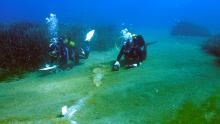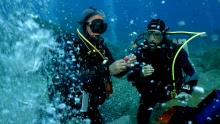Exkursion to Italy-Panarea
With an area of 3.4 km², Panarea is the smallest of the 7 Aeolian (or Lipari) islands. Located in the southern Tyrrhenian Sea (approx. 50 km north of Sicily), this volcanic archipelago is part of the Aeolian arc, the formation of which was caused by the subduction of the northern edge of the African plate under the Apulian plate.
Since 2000, the Aeolian Islands have been a UNESCO World Heritage Site in the fields of volcanology and geology.
Panarea is part of the recently active volcanic and thus actuogeological system of the Stromboli volcano on the island of the same name. Typical features of such a volcanically active system, such as gas emissions and hydrothermal water, can be observed when diving and at the water surface.
The CO2 probably originates from the Earth's mantle and the subducting Earth plate or the decomposition of carbonates from marine sediments. The gas composition and the gas volume flow change over time and allow indications and conclusions to be drawn about changes in the magma.
The largest recent crisis with strong eruptions occurred on 3 November 2002, when a sudden significant increase in gas emissions and hydrothermal fluids was detected near the islands of Bottaro and Lisca Bianca, about 2.5 km east of Panarea. The eruptions decreased to a state of low degassing by July 2003. In almost the same period, from 28 December 2002 to 22 July 2003, there was an increase in volcanic activity on the island of Stromboli.
A series of seismic and volcanological events in the region, such as the offshore earthquake on 6 September 2002 between Palermo and the island of Ustica - followed by several hundred aftershocks up to December 2002 - and the eruption of Mount Etna between 27 October 2002 and 28 January 2003, were linked to the above-mentioned events.

